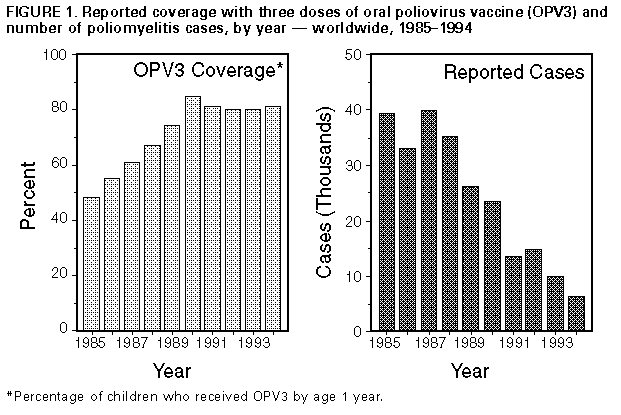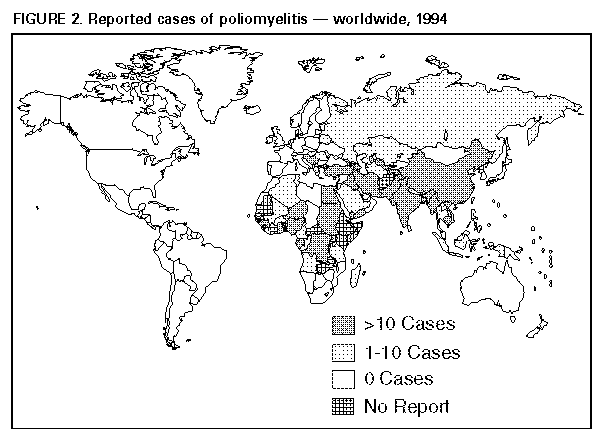 |
|
|
|
|
|
|
| ||||||||||
|
|
|
|
|
|
|
||||
| ||||||||||
|
|
|
|
|
Persons using assistive technology might not be able to fully access information in this file. For assistance, please send e-mail to: mmwrq@cdc.gov. Type 508 Accommodation and the title of the report in the subject line of e-mail. Progress Toward Global Poliomyelitis Eradication, 1985-1994In 1985, the Pan American Health Organization (PAHO) established as a goal the elimination of poliomyelitis from the Western Hemisphere by 1990; the last confirmed case of paralytic polio caused by wild poliovirus occurred in 1991 in Peru (1). In 1988, the World Health Assembly established the objective of global polio eradication by the year 2000 (2). Substantial progress toward this goal has resulted from the use of four strategies recommended by the World Health Organization (WHO): 1) maintenance of high vaccination coverage levels among children with at least three doses of oral poliovirus vaccine (OPV); 2) development of sensitive systems of epidemiologic and laboratory surveillance, including use of the standard WHO case definition * ; 3) administration of supplementary doses of OPV to all young children (usually those aged less than 5 years) during National Immunization Days (NIDs) ** to rapidly interrupt poliovirus transmission; and 4) "mopping-up" vaccination campaigns -- localized campaigns targeted at high-risk areas where wild poliovirus transmission is most likely to persist at low levels (3). This report summarizes progress toward global polio eradication from 1985 through 1994 based on data submitted to WHO as of March 20, 1995. Worldwide. From 1985 through 1990, routine vaccination coverage levels increased from 47% to 85% and stabilized at 80%-81% during 1991-1994 Figure_1. From 1985 through 1994, the number of cases reported annually decreased 84%, from 39,361 to 6241 Figure_1. The number of countries reporting polio cases decreased steadily, from 1985 (99 {51%} of 196) to 1988 (88 {45%} of 196) and 1994 (51 {24%} of 214) Figure_2. In addition, the number of countries reporting zero polio cases increased from 1985 (84 {43%}) to 1988 (104 {53%}) and 1994 (145 {68%}) ***. The number of countries with endemic polio that conducted NIDs each year increased from 15 in 1988 to 37 as of April 14, 1995; 24 additional countries have scheduled their first NIDs for later in 1995. A total of 94 countries have implemented surveillance for acute flaccid paralysis (AFP) to detect all cases of polio that meet the standard WHO case definition and to monitor the circulation of wild polioviruses. WHO has certified 12 regional reference laboratories and 60 national laboratories as members of the Global Polio Laboratory Network and has designated six geographic areas as emerging polio-free zones ****: the Western Hemisphere, Western and Central Europe, North Africa, Southern and Eastern Africa, the Middle East, and the Western Pacific. African Region. Polio remains endemic in most countries of West and Central Africa. In 1994, a total of 448 cases were provisionally reported from 20 countries, a decrease of 73% from 1993 (1636 cases) and 98% from 1988 (4564 cases); 12 countries have not yet reported to WHO for 1994; seven countries did not report in 1993. The number of countries reporting zero polio cases increased from eight in 1988 to 16 in 1994; most are island nations or located in southern Africa. Region of the Americas. The last case of indigenous polio in the Americas was reported from Peru in 1991. In September 1994, an international commission convened by PAHO certified that indigenous transmission of wild poliovirus had been interrupted in the Americas (1). Eastern Mediterranean Region. From 1988 through 1994, reported cases of polio decreased 58%, from 2342 to 973. In 1994, the 520 cases reported in Pakistan accounted for 53% of the regional total, although the number of cases within Pakistan declined 71% from 1993 (1803 cases). Pakistan conducted its first NIDs in April and May 1994. Coordinated NIDs are scheduled to be held during March-May 1995 in seven countries (Afghanistan, Iran, Iraq, Jordan, Lebanon, Pakistan, and Syria) and in Gaza, Jericho, and the West Bank (4). These countries reported 669 (69%) of the 973 cases reported in the region during 1994 (4). European Region. The number of reported polio cases in the region has been stable during the 1990s: during 1994, a total of 211 cases were reported, compared with 202 cases in 1993 and 204 cases in 1988. NIDs are scheduled to be held during March-May 1995 in 10 countries (Armenia, Azerbaijan, Bulgaria, Georgia, Kazakhstan, Kyrgyzstan, Tajikistan, Turkey, Turkmenistan, and Uzbekistan) (4). These countries accounted for 200 (95%) of the 211 cases reported in the region during 1994. Southeast Asian Region. From 1988 through 1994, the number of reported cases of polio decreased 84%, from 25,711 to 4184. The number of cases reported in India in 1994 (3867 cases) accounted for 93% of the regional total and 62% of the global total. Western Pacific Region. From 1988 through 1994, the number of reported polio cases decreased 80%, from 2126 to 425. In 1994, polio was reported by five of 35 countries in the region (Cambodia, People's Republic of China, the Lao People's Democratic Republic, Philippines, and Vietnam). The number of cases reported by China (158 cases) was a 71% decrease from 1993 (538 cases) and a 97% decrease from 1990 (5065 cases); WHO-recommended strategies for polio eradication were implemented in China in 1991. Reported by: Expanded Program on Immunization, Global Program for Vaccines and Immunization, World Health Organization, Geneva. International Health Program Office; Div of Viral and Rickettsial Diseases, National Center for Infectious Diseases; Polio Eradication Activity, National Immunization Program, CDC. Editorial NoteEditorial Note: Major achievements in the coordinated global campaign to eradicate polio include the substantial reduction in the global incidence of paralytic polio, the complete elimination of polio from the Region of the Americas, and the widespread implementation of NIDs and other WHO-recommended strategies. In particular, the number of reported cases declined dramatically in countries that conducted NIDs in late 1993 or the first half of 1994 (including China, Pakistan, Sudan, and Vietnam). In addition, during March-May 1995, coordinated NIDs targeting 56 million children aged less than 5 years will be conducted in 18 contiguous countries in Europe, Central and South Asia, and the Middle East (4). The implementation of AFP surveillance is a critical element of WHO's eradication strategies. Eradication of disease requires a surveillance system that can detect a single case. Polio-endemic countries have implemented a system in which any AFP case in a person aged less than 15 years is reported as a suspected polio case. Two stool specimens are collected from each suspected case-patient at an interval of 24-48 hours to determine the presence of poliovirus; however, the standard WHO case definition permits an AFP case to be confirmed as polio if it meets any of four criteria, including the isolation of poliovirus from a stool specimen. Accurate and timely surveillance information about wild poliovirus transmission enables the targeting of supplementary vaccination activities toward remaining known reservoirs of poliovirus through intensive, localized vaccination campaigns (i.e., mopping-up vaccination). AFP surveillance also is being used to certify eradication at the national, regional, and global levels. In 1994, the contiguous countries of Bangladesh, India, and Pakistan accounted for 73% of the global total of polio cases. Since 1988, importation of wild poliovirus from these polio-endemic countries of Southeast Asia has accounted for many of the outbreaks or sporadic cases of polio in previously polio-free countries of Europe, the Middle East, and North America. Because Southeast Asia remains a major global reservoir of polioviruses, full implementation of the WHO-recommended polio eradication strategies in these countries is a high priority. The global eradication of polio by the year 2000 will require that all polio-endemic countries implement NIDs and other WHO-recommended strategies by 1997. Implementation of these strategies is especially important in the African Region, which has the largest number of countries not reporting polio surveillance data; the African Regional Office of WHO is assisting countries in strengthening polio surveillance and planning for NIDs. Although global routine vaccination coverage levels remained stable during 1990-1994, reported polio cases declined substantially, largely because of an increase in the number of countries conducting NIDs. Despite substantial progress toward global eradication of polio, several challenges remain, including 1) increasing vaccination levels in unvaccinated subpopulations; 2) preventing the reintroduction of wild poliovirus into polio-free areas by eliminating reservoirs in polio-endemic countries (particularly in the Indian subcontinent); 3) increasing the awareness of donor agencies and governments in industrialized countries of the substantial financial and humanitarian benefits of global eradication of polio, thus engendering support from unaffected countries beyond that already provided by organizations such as Rotary International; 4) encouraging all countries that remain polio-endemic to make polio eradication a priority activity, including the implementation of NIDs and the initiation of AFP surveillance; and 5) providing support to vaccination program managers for training to develop managerial skills for implementing and maintaining effective vaccination and surveillance programs in all countries. The success of the polio eradication initiative will depend on finding solutions to these financial, managerial, political, and technical challenges. References
* A confirmed case of polio is defined as acute flaccid paralysis (AFP) and at least one of the following: 1) laboratory-confirmed wild poliovirus infection, 2) residual paralysis at 60 days, 3) death, or 4) no follow-up investigation at 60 days. ** Mass campaigns over a short period (days to weeks) in which two doses of OPV are administered to all children in the target age group, regardless of prior vaccination history, with an interval of 4-6 weeks between doses. *** The difference between the number of countries reporting polio cases or zero cases and the total number of countries reflects those not submitting reports. **** Geographic areas where wild poliovirus either has disappeared or is at such a low level that eradication could be rapidly achieved. Figure_1  Return to top. Figure_2  Return to top. Disclaimer All MMWR HTML versions of articles are electronic conversions from ASCII text into HTML. This conversion may have resulted in character translation or format errors in the HTML version. Users should not rely on this HTML document, but are referred to the electronic PDF version and/or the original MMWR paper copy for the official text, figures, and tables. An original paper copy of this issue can be obtained from the Superintendent of Documents, U.S. Government Printing Office (GPO), Washington, DC 20402-9371; telephone: (202) 512-1800. Contact GPO for current prices. **Questions or messages regarding errors in formatting should be addressed to mmwrq@cdc.gov.Page converted: 09/19/98 |
|||||||||
This page last reviewed 5/2/01
|